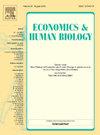Maternal mortality, tuberculosis and social deprivation in Madrid during the second and third decades of the 20th century
IF 1.8
3区 医学
Q2 ECONOMICS
引用次数: 0
Abstract
In this paper we jointly study maternal mortality and tuberculosis during the second and third decades of the 20th century in Madrid. Nicknamed the “city of death”, the Spanish capital was marked by a high mortality where tuberculosis accounted for approximately 26/28 % of all deaths of women of reproductive age. Using a large longitudinal individual-level database including causes of death, we discuss the definitions of maternal mortality, then highlight its high level in the Spanish capital. However, the risk of dying was significantly lower for migrant women than for native. In the context studied, an evident example of the “healthy migrant” paradox with selection at origin is outlined. At the same time, there are clear links between tuberculosis as a cause of death during the 60 days following a delivery and the socio-spatial inequalities characteristic of a city that saw wealthy areas side by side with disadvantaged areas, characterized by low standards of living conditions and insufficient hygiene. The results of the statistical models analyzed are controlled for geographic, social and biological variables in addition to individual demographic characteristics. The robustness of the results is ensured by the size of the sample used, which allowed us to study an event - a death following delivery - that, even at the time of this study, was rare.
20世纪第二和第三个十年期间马德里的产妇死亡率、结核病和社会剥夺
在本文中,我们共同研究了20世纪第二和第三个十年在马德里的孕产妇死亡率和结核病。西班牙首都被称为“死亡之城”,死亡率很高,在育龄妇女死亡总数中,结核病约占26% / 28% %。利用包括死亡原因在内的大型纵向个人层面数据库,我们讨论了孕产妇死亡率的定义,然后强调了西班牙首都的高水平。然而,移民妇女的死亡风险明显低于本地妇女。在所研究的背景下,概述了“健康移民”悖论的一个明显例子,其起源是选择。与此同时,作为产后60天内死亡原因之一的结核病与一个城市特有的社会空间不平等之间存在明显的联系,这个城市的富裕地区与生活条件低、卫生条件差的贫困地区并存。统计模型分析的结果除了个人人口特征外,还控制了地理、社会和生物变量。所用样本的大小保证了结果的稳健性,这使我们能够研究一个事件-分娩后死亡-即使在这项研究的时候,也是罕见的。
本文章由计算机程序翻译,如有差异,请以英文原文为准。
求助全文
约1分钟内获得全文
求助全文
来源期刊

Economics & Human Biology
医学-公共卫生、环境卫生与职业卫生
CiteScore
4.50
自引率
12.00%
发文量
85
审稿时长
61 days
期刊介绍:
Economics and Human Biology is devoted to the exploration of the effect of socio-economic processes on human beings as biological organisms. Research covered in this (quarterly) interdisciplinary journal is not bound by temporal or geographic limitations.
 求助内容:
求助内容: 应助结果提醒方式:
应助结果提醒方式:


